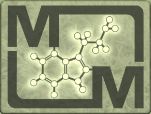 |
MAGISKA MOLEKYLERS WIKI |
Paddor
Generell information
Vissa sorters paddor producerar bufotenin och 5-MeO-DMT i k├Črtlar p├ź ryggen. Man kan mj├Člka paddorna, torka slemmet och extrahera fram de aktiva ├żmnena, eller r├Čka slemmet som det ├żr. Trots att uppgifterna nedan n├żmner torkat paddskinn (vilket inneb├żr att paddan m├źste d├Čdas) s├ź ├żr detta ej n├Čdv├żndigt, genom f├Črsiktig mj├Člkning s├ź kan de leva vidare utan att ta skada.
Att man skulle kunna slicka paddor f├Čr att bli h├Čg ├żr en n├źgot ├Čverdriven sanning, som bland annat ├źterber├żttas i ett avsnitt av The Simpsons (S11E15) d├żr Homer slickar en padda och omedelbart f├źr stora pupiller. Det finns dock vissa arter d├żr det faktiskt ├żr m├Čjligt. P├ź tal om att slicka paddor, ni kommer v├żl ih├źg den gamla sagan alla troligen har h├Črt om som barn d├żr prinsessan kysser en groda som f├Črvandlas till en prins. N├źgon borde ber├żttat f├Čr henne att hon skulle r├Čkt slemmet ist├żllet...
Arter
Arter med signifikant bufotenininneh├źll:
| Namn | Inneh├źller |
|---|---|
| Bufo americanus | 1- 100 ug/g skinn |
| Bufo alvarius | 0.1 - 5.0 mg/g i stora sekretk├Črtlar (medel 1.2 mg/g i k├Črtelv├żvnad) och fr├źn 0.17-2.2 mg/g (medel 0.9 mg/g) i resten av det torkade skinnet[1] , men den psykoaktiva effekten beror fr├żmst p├ź att k├Črtlarna inneh├źller 5 - 15% 5-MeO-DMT. |
| Bufo arenarum | 5.1 mg/g i torkat skinn[2] |
| Bufo bufo (Vanlig padda) | 0.33% i torkat sekret[3] |
| Bufo calamita | 100 - 1000 ug/g skinn |
| Bufo. chilensis | N/A[4] |
| Bufo crucifer | 1- 100 ug/g skinn |
| Bufo formosus | N/A[5] |
| Bufo fowleri | 1- 100 ug/g skinn |
| Bufo gargarizans | N/A[6] |
| Bufo marinus (=Rhinella marina) | Mycket varierande, vissa helt utan |
| Bufo melanosticus | N/A[6] |
| Bufo paracnemis | 1 - 10 mg/g skinn |
| Bufo viridis | 640 ug/g f├żrskt skinn[7] |
Se ├żven artikeln om grodan Phyllomedusa bicolor.
Om inneh├źllet
Bufo marinus (numera k├żnd under namnet Agapadda, Rhinella marina, Bufo americanus och f├Črmodligen ├żven flera andra arter b├Čr undvikas eftersom dom inneh├źller ├żmnen (bufotoxiner) som inte ├żr bra f├Čr h├żlsan[10]. Se ├żven k├żlla[6] f├Čr mer information om olika bufotoxiner.
Agapadda:
| ŌĆ£ | Originally from the Americas, Bufo marinus was introduced to Australia, where it is now known as the cane toad and its secretions are allegedly used as a psychoactive drug. Under QueenslandŌĆÖs Drug Misuse Act, bufotenine is an illegal substance in Australia (Ingram 1988, 66). In recent years, the press has been reporting increasing cases of toad lickinŌĆÖ (Lyttle 1993), a practice in which the secretions of Bufo marinus are licked off the toad: When licking the expressed secretions (abusers reported that it is possible to ŌĆ£milkŌĆØ twice a day), a furry sensation on the lips and tongue quickly becomes manifest. Five to ten (up to 30) minutes later, nausea is common, and only 20 to 30 minutes after ingestion, sometimes earlier, hallucinations of various kinds set in, beginning more rapidly and not lasting as long as with LSD. (Keup 1995, 12) The thickened juice of boiled animals is also ingested in Australia (Keup 1995, 14). A decoction of the dried skin (known as cane skin tea) is also used (Der Spiegel 32 [1994]: 92). The secretions from Bufo marinus contain catecholamines (dopamine, N-methyldopamine, adrenaline, noradrenaline) and tryptamines (serotonin, N-methyl-serotonin, bufotenine, bufotenidine, dehydrobufotenine), as well as glycoside-like toad toxins (Deulofeu and R├║veda 1971; Lyttle 1993, 523 f.). The skin has been found to contain morphine. The toad toxins (bufotoxine, bufogenine, and bufadienolides) are cardiotoxic and are similar to digitalis in their effects: nausea, vomiting, increase in blood pressure, confusion, and psychotic states (Keup 1995, 12). Smoking is probably the safest method to ingest Bufo marinus secretions, as the burning process apparently destroys the toxic components while leaving the bufotenine intact (Alexander Shulgin, pers. comm.). The ethnobotanist Brett Blosser smoked dried Bufo marinus secretions (approximately 1 mg every few minutes) and reported experiencing tryptamine-like hallucinations similar to those induced by the secretions of Bufo alvarius (cf. 5-MeODMT) (B. Blosser, pers. comm.). The few reports of the effects of smoked toad skin indicate that they are hallucinogenic. One Australian user stated, ŌĆ£I am seeing the world through the consciousness of a toadŌĆØ (Lewis 1989, 71). ŌĆö R├żtch - The Encyclopedia of Psychoactive Plants |
ŌĆØ |
Vanlig padda:
B├Čr f├Črmodligen ocks├ź undvikas. Sekretet inneh├źller f├Črutom bufotenin ├żven bufotenidin[11] som ├żr HT3- och ╬▒7-nAChR-agonister och framkallar f├Črmodligen illam├źende.
| ŌĆ£ | The common toad (Bufo bufo) was sacred to the Germanic and Baltic peoples. Only with the introduction of Christianity was the toad demonized and declared to be an animal of the devil.
The active constituent bufotenine was first isolated from secretions of the common toad. The heathen tribes of the Baltic region venerated the toad as a goddess. It is possible that they were aware of the psychoactive effect of the toadŌĆÖs secretions. |
ŌĆØ |
Videoklipp
Dobby's story. Om en hund som gillar att slicka p├ź AgapaddorExterna l├żnkar
- Ōåæ Erspamer et al 1967
- Ōåæ Wieland et al. 1934
- Ōåæ Wieland & Behringer 1941
- Ōåæ 4,0 4,1 Deulofeu & R├║veda (1971)
- Ōåæ Ohno et al. 1961
- Ōåæ 6,0 6,1 6,2 The Development of Toad Toxins as Potential Therapeutic Agents (Qi, 2018)
- Ōåæ Erspamer 1961
- Ōåæ R├żtch - The Encyclopedia of Psychoactive Plants
- Ōåæ DMT Nexus Wiki: Bufotenin
- Ōåæ Erowid: Bufo alvarus vs Bufo americanus?
- Ōåæ N-Methyl Serotonin Analogues from the Bufo bufo Toad Venom Interact Eff iciently with the ╬▒7 Nicotinic Acetylcholine Receptors (Kryukova, 2017)
Sidan ├żndrades senast 22 februari 2020 klockan 10.29.
Den h├żr sidan har visats 19┬Ā847 g├źnger.











